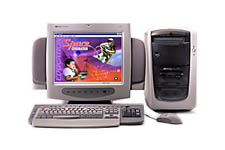



![]()
![]()
![]()
![]()
11. Be aware that the General MIDI Standard has a patch hierarchy. 0 level patches are oriented towards Pianos, followed by barred instruments, organs, guitars etc. Channel 10 is devoted to percussion. I have found that as accompaniments are developed in the sequencer it is a good idea to conform to this standard before exporting your files to Standard MIDI Format. There seems to be less confusion for those downloading and reading the files.
![]()
Sam Reese, Professor at the University of Illinois, has an outstanding page including his own work and examples of those in his classes. At this site he has prepared a neat page describing "how to put sounds on your web page" which includes a blues example that allows the player to both visualize the chord progressions and improvise at the same time.
Home Practice on Line by Dr. Anthony Scott Watson,
teacher at the Parkland School District in Allentown, PA, illustrates how the Web can be used by children in school music organizations for home practice. Dr. Watson, who presented last year,
provides students with materials that can be used for current practice and improvisation activities.
Of interest is the inclusion of past-played compositions. Students who have graduated on, can return to the page to relive fond memories, and play past favorites, as well as keeping current regarding musical
activities of their "alma mater" ensemble and review past skills.
Examples on the Fourth Grade Band page include accompaniments that correspond with the band methods that are used during school rehearsals.
Such application of technology allows the student to go home and "self-reinforce" the instruction that was done at the rehearsal sessions during the day. It also allows the parents to view, see and hear the activities occurring in the music education program at the local school and hear the progress their children are making. It also gives parents a chance to "help" or feel some importance in the support and encouragement of their children's music education activities, rather than the usual one-night of participation by attending the final concert.
In 1983 he changed direction in life, leaving his profession to study saxophone, piano, and jazz at Adelaide University for 6 years. Gradually he got into teaching and writing books and courses on music education. Now he lives on the Sunshine Coast in Queensland (Australia) and works full-time on Jazclass his "Award Winning" Music Education site which includes lessons, email courses, and books on Jazz, Blues, modern music theory, keyboard and saxophone. To request further information questions may be sent on to Michael Furstner. There are many neat things on this page for the musician. It is a good source for practicing techniques and scales. For example: an exercise of ascending and descending thirds is available.
![]()